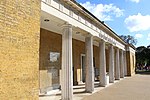Diana, Princess of Wales Memorial Fountain

The Diana, Princess of Wales Memorial Fountain is a memorial in London dedicated to Diana, Princess of Wales, who died in a car crash in 1997. It was designed to express Diana's spirit and love of children.The fountain is located in the southwest corner of Hyde Park, just south of the Serpentine lake and east of the Serpentine Gallery. Its cornerstone was laid in September 2003 and it was officially opened on 6 July 2004 by Queen Elizabeth II. Also present were Diana's younger brother Charles Spencer, her ex-husband Prince Charles (the future Charles III), her sons Prince William and Prince Harry, her ex–father-in-law Prince Philip and her two sisters Lady Jane Fellowes and Lady Sarah McCorquodale. The opening ceremony brought the Windsors and the Spencers together for the first time in seven years.
Excerpt from the Wikipedia article Diana, Princess of Wales Memorial Fountain (License: CC BY-SA 3.0, Authors, Images).Diana, Princess of Wales Memorial Fountain
Rotten Row, London Knightsbridge
Geographical coordinates (GPS) Address External links Nearby Places Show on map
Geographical coordinates (GPS)
| Latitude | Longitude |
|---|---|
| N 51.504647222222 ° | E -0.17150833333333 ° |
Address
Diana Memorial Fountain
Rotten Row
SW7 1SE London, Knightsbridge
England, United Kingdom
Open on Google Maps










